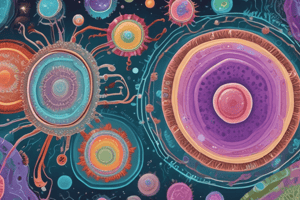Podcast
Questions and Answers
Match the following cell components with their respective types of microorganisms:
Match the following cell components with their respective types of microorganisms:
Cell Wall = Both Prokaryotic and Eukaryotic Cells Plasma Membrane = Both Prokaryotic and Eukaryotic Cells Nucleus = Eukaryotic Cells Nucleoid = Prokaryotic Cells
Match the following cell components with their functions:
Match the following cell components with their functions:
Ribosomes = Protein Synthesis Flagella = Cell Motility Pili and Fimbriae = Cell Adhesion Plasmids = Horizontal Gene Transfer
Match the following cell components with their respective locations:
Match the following cell components with their respective locations:
Cytoplasm = Inside the Plasma Membrane Endoplasmic Reticulum (ER) = Eukaryotic Cells Golgi Apparatus = Eukaryotic Cells Mitochondria = Eukaryotic Cells
Match the following key processes with their descriptions:
Match the following key processes with their descriptions:
Match the following cell components with their functions in Eukaryotic Cells:
Match the following cell components with their functions in Eukaryotic Cells:
Match the following cell components with their functions in Prokaryotic Cells:
Match the following cell components with their functions in Prokaryotic Cells:
Match the following key applications with their relevance to Microbiology:
Match the following key applications with their relevance to Microbiology:
Match the following cell components with their characteristics:
Match the following cell components with their characteristics:
Flashcards are hidden until you start studying
Study Notes
Microbiology Basics
- Microbiology is the study of microorganisms, which are tiny, often single-celled organisms.
- Microorganisms play crucial roles in various environments, including human health, ecology, and industry.
Prokaryotic Cells (Bacteria and Archaea)
- Cell Wall: rigid, outermost layer that maintains cell shape and provides protection.
- Plasma Membrane: semi-permeable membrane that regulates the flow of substances in and out of the cell.
- Cytoplasm: jelly-like substance where metabolic processes occur.
- Nucleoid: region where genetic material is found, but lacks a true nucleus.
- Ribosomes: site of protein synthesis.
- Flagella: whip-like structures used for movement.
- Pili and Fimbriae: hair-like structures used for attachment and DNA transfer.
- Plasmids: small, self-replicating circular DNA molecules that can be exchanged between cells.
Eukaryotic Cells (Fungi, Protozoa, Algae)
- Cell Wall: varies in composition and function depending on the organism.
- Plasma Membrane: similar to prokaryotic cells, regulates the flow of substances in and out of the cell.
- Cytoplasm: similar to prokaryotic cells, where metabolic processes occur.
- Nucleus: membrane-bound organelle that contains genetic material.
- Ribosomes: site of protein synthesis.
- Endoplasmic Reticulum (ER): network of membranous tubules and cisternae involved in protein synthesis and transport.
- Golgi Apparatus: complex of flattened sacs and tubules involved in protein modification and transport.
- Mitochondria: site of cellular respiration.
- Chloroplasts (in algae): site of photosynthesis.
- Lysosomes: membrane-bound organelles containing digestive enzymes.
- Cytoskeleton: network of filaments that provides structural support and shape.
Key Functional Processes
- Metabolism: conversion of energy and nutrients into cellular components.
- Reproduction: process by which microorganisms produce new cells.
- Genetic Variation: changes in genetic material that occur through mutation, gene transfer, and recombination.
- Response to Environment: adaptation to changes in temperature, pH, and other environmental factors.
Studying That Suits You
Use AI to generate personalized quizzes and flashcards to suit your learning preferences.




